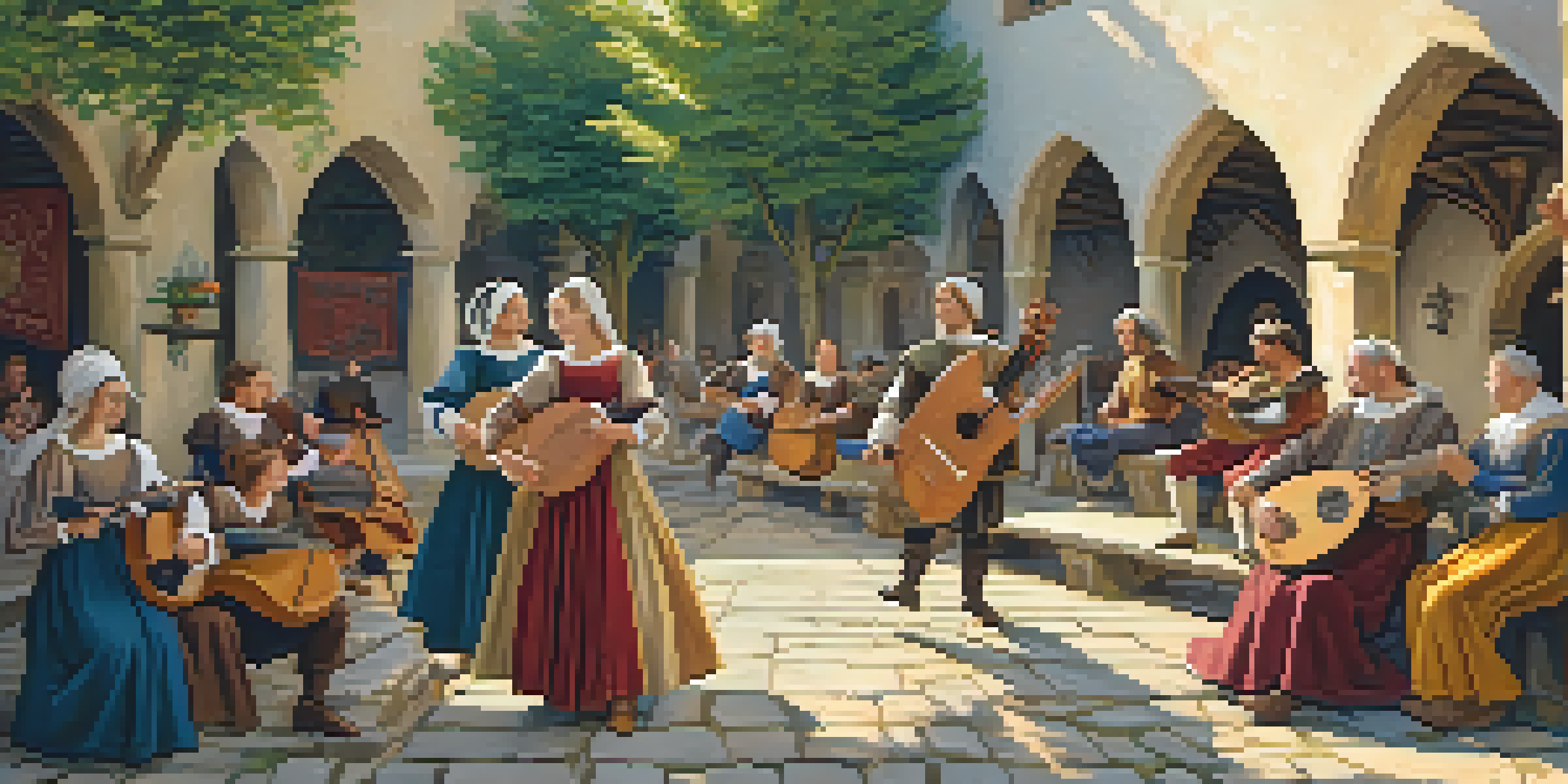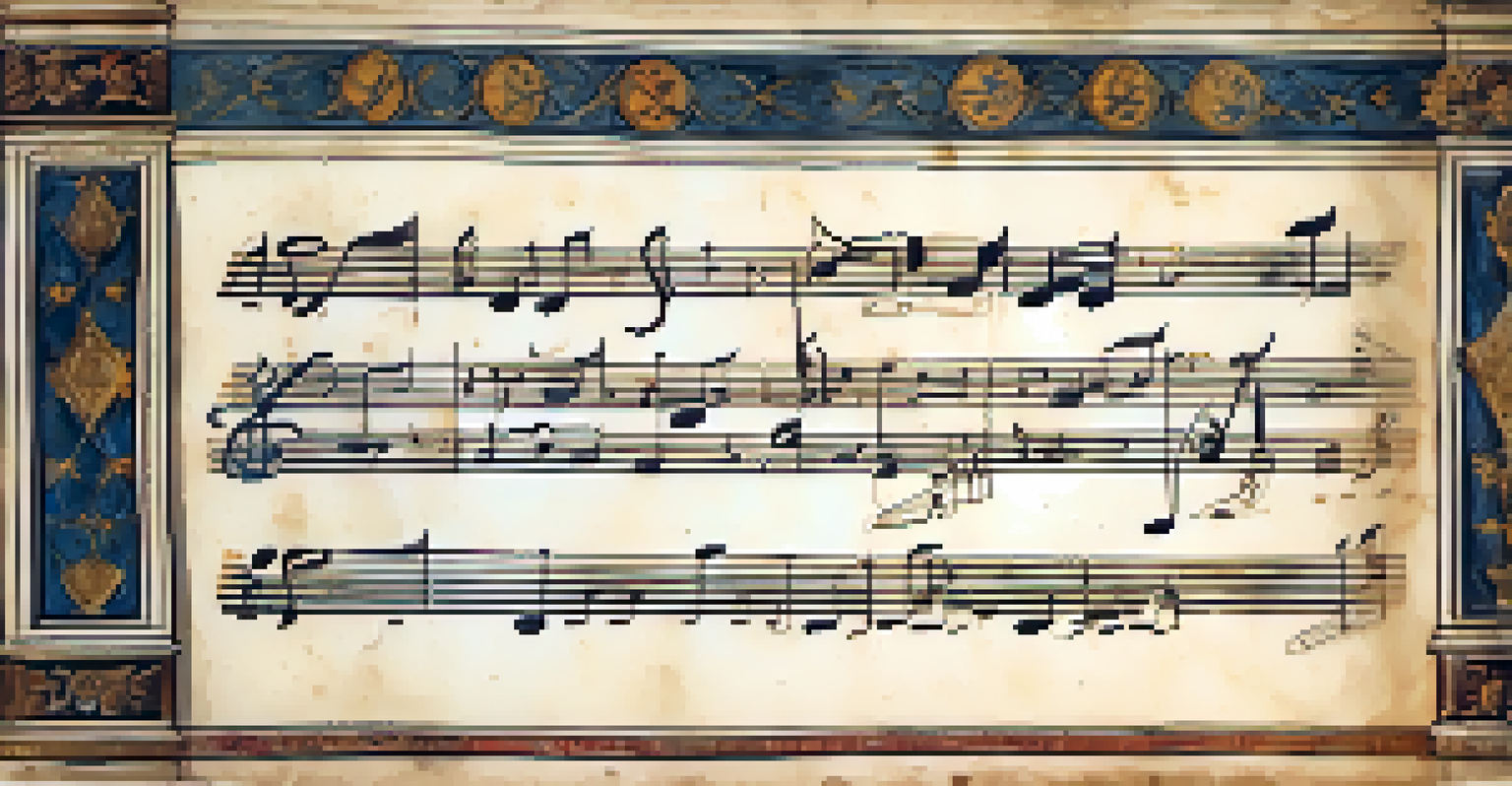The Rise of Instrumental Music in the Late Medieval Period

Understanding the Late Medieval Musical Landscape
The late medieval period, roughly from the 14th to the 15th centuries, was a time of significant change in music. During this era, the focus began to shift from purely vocal compositions to a greater emphasis on instrumental music. This evolution was influenced by various factors, including cultural exchanges and the emergence of new musical forms.
Music is the shorthand of emotion.
At the heart of this transformation was the rise of the secular music scene, where instruments began to take center stage in performances. The use of instruments such as the lute, vielle, and recorder became more prevalent, allowing for a richer and more diverse sound palette. This shift not only changed the way music was created but also how it was experienced by audiences.
Additionally, the growing popularity of instrumental music coincided with advancements in instrument-making techniques. Craftsmen began to produce more refined instruments, leading to improved sound quality and playability. This newfound quality encouraged musicians to explore and experiment, paving the way for the intricate instrumental compositions that would follow.
Cultural Influences on Instrumental Music Development
The late medieval period was marked by significant cultural exchanges, particularly due to trade and exploration. These interactions introduced new musical styles and instruments from various regions, enriching the musical tapestry of Europe. As musicians traveled and shared their art, they brought different influences that contributed to the emergence of instrumental music.

For instance, the Moorish influence in Spain led to the incorporation of unique rhythms and instruments, such as the oud, into European music. Similarly, the Renaissance's birth in Italy saw the blending of various musical traditions, creating a fertile ground for instrumental experimentation. This dynamic exchange fostered a creative environment where musicians could innovate and collaborate.
Shift to Instrumental Music
The late medieval period marked a significant transition from vocal compositions to a greater emphasis on instrumental music.
Moreover, the rise of courts and patronage systems encouraged composers to write for instrumental ensembles. Nobles and wealthy patrons sought to showcase their status through music, promoting the creation of elaborate instrumental works. This demand played a crucial role in solidifying instrumental music's place within the cultural hierarchy of the time.
The Role of Instruments in Social and Religious Contexts
Instrumental music during the late medieval period was not confined to the concert hall; it played an essential role in social and religious contexts. In both secular and sacred ceremonies, instruments were utilized to enhance the overall experience. For example, during church services, instruments began to accompany choirs, adding depth and richness to the vocal performances.
The only truth is music.
Social gatherings, such as dances and festivals, also featured instrumental music prominently. Musicians would perform lively tunes, encouraging people to engage in communal dances. This practice underscored the importance of music in fostering social bonds and creating shared experiences within communities.
As the church began to embrace instrumental music, it signified a shift in attitudes toward the use of instruments in worship. While earlier periods viewed instruments with suspicion, the late medieval era saw their acceptance as a means to uplift the human spirit and enhance spiritual expression.
Emergence of Instrumental Genres and Forms
With the rising popularity of instrumental music, new genres and forms began to emerge. The late medieval period saw the development of distinct instrumental styles, such as the estampie and the saltarello. These forms typically featured lively rhythms and were often performed during social gatherings, showcasing the joyful spirit of the era.
Moreover, the rise of polyphony in vocal music influenced instrumental composition as well. Musicians began to experiment with layering multiple melodic lines, leading to the creation of complex instrumental arrangements. This experimentation laid the groundwork for future developments in Western classical music.
Cultural Influences Enrich Music
Cultural exchanges during this time introduced new musical styles and instruments, fostering creativity and collaboration among musicians.
As composers started to write specifically for instruments, the concept of the sonata began to take shape. This marked a pivotal moment in music history, as it highlighted the importance of instrumental music as an independent art form, separate from vocal traditions.
Notable Instrument Makers and Innovations
The late medieval period also witnessed significant advancements in instrument-making, driven by the demand for high-quality instruments. Craftsmen began to specialize in creating specific instruments, leading to innovations in design and construction. This specialization allowed for the refinement of existing instruments and the creation of new ones.
For example, the lute became a staple of the late medieval music scene, with luthiers experimenting with its shape and string composition to enhance its sound. Similarly, the development of wind instruments like the sackbut and shawms showcased the artisans' ingenuity and skill, allowing musicians to explore new tonal possibilities.
These innovations not only improved the quality of music but also expanded the repertoire available to musicians. As instruments became more versatile, composers could experiment with different sound combinations, fostering a culture of creativity and exploration in instrumental music.
Influence of Manuscript Culture on Instrumental Music
During the late medieval period, the proliferation of manuscript culture played a crucial role in preserving and disseminating instrumental music. As scribes documented musical compositions, they ensured that new instrumental works could be shared across regions and generations. This practice created a foundation for the transmission of musical knowledge and styles.
Manuscripts often included detailed instructions for performers, providing insights into playing techniques and stylistic choices. This documentation was vital in teaching musicians about the emerging instrumental repertoire and fostering a sense of community among players. Sharing these manuscripts helped establish a common musical language.
Legacy of Instrumental Innovations
The advancements in instrument-making and the emergence of new genres set the foundation for the instrumental music that flourished in the Renaissance.
Furthermore, the rise of music notation allowed for greater complexity in instrumental compositions. As composers began to experiment with new forms and structures, they relied on notation systems to convey their ideas. This development not only advanced instrumental music but also laid the groundwork for future musical notation practices.
The Legacy of Late Medieval Instrumental Music
The late medieval period set the stage for the flourishing of instrumental music in the Renaissance and beyond. The innovations and developments of this time had a lasting impact on the trajectory of Western music. As instrumental compositions became more sophisticated, they influenced subsequent generations of composers and musicians.
Moreover, the growing acceptance of instrumental music in both secular and sacred contexts marked a significant cultural shift. This transition contributed to the establishment of instrumental music as a respected art form, paving the way for its prominence in later musical styles. The groundwork laid during this period remains evident in the music we enjoy today.

In essence, the rise of instrumental music during the late medieval period was a pivotal moment in the history of music. It not only transformed the musical landscape of the time but also left an indelible mark on the evolution of music itself, shaping a future where instrumental music thrives.